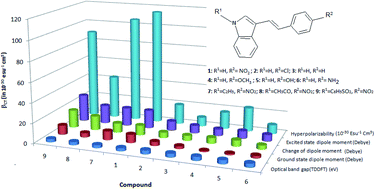Optical properties of 3-substituted indoles†
Abstract
The optical properties of various donor or acceptor p-phenyl substituted ethenyl indoles were studied in solvents of varying polarity using absorption, fluorescence and TDDFT methods. Ethenyl indole exhibits non-linear optical properties (NLO) in a substituent dependent manner. Compound with a strong electron-attracting substituent, shows large NLO properties with charge transfer behavior, whereas ethenyls with moderate electron withdrawing or electron donating substituent exhibit lower NLO properties with non polar excited state. A highly dipolar excited state for p-nitro phenyl substituted ethenyl indoles (μe: 18.2–27.1 debye; Δμ: 9.4–17.8 debye) is observed as compared to other ethenyls (μe: 6.6–9.5 debye; Δμ: 4.2–6.2 debye). From TDDFT study, it is shown that the HOMO–LUMO energy of ethenyl is increased with increasing the electron donating ability of the p-phenyl substitution. The optical band gap of ethenyl 3 without substitution, is decreased upon p-phenyl substitution either with an electron withdrawing (Cl, NO2) or an electron donating (OCH3, OH, NH2) substituent. The compound with a strong electron accepting, p-nitrophenyl ethenyl indole 1 shows 12 times better NLO response as compared to the reference ethenyl indole 3 (β: 1: 115 × 10−30 esu−1 cm5, 3: 9 × 10−30 esu−1 cm5). Ethenyls 2–6 bearing a weak or moderately electron withdrawing or electron accepting substituent, exhibit lower NLO response. The β of ethenyl is increased with increasing the order of electron withdrawing nature of phenyl ring. Overall, a correlation of β with the optical band gap, ground state dipole moment, % of charge transfer in the ground and excited state is found.



 Please wait while we load your content...
Please wait while we load your content...